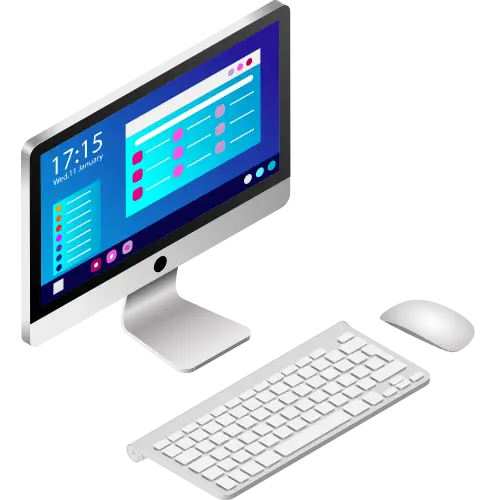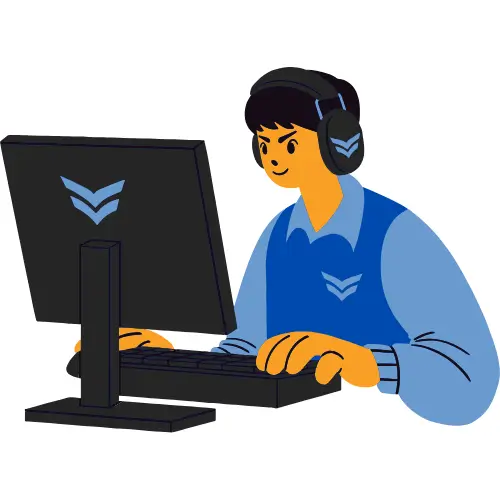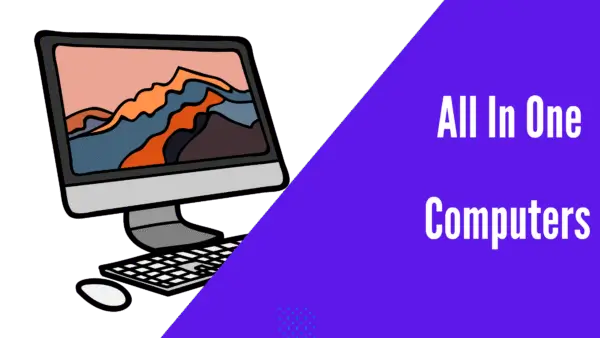Last updated on August 21st, 2025 at 06:29 pm

Are you in the market to buy an all-in-one computer? Are you an ICT student wondering what an all-in-one computer is? Do you want to know if an AIO system is a good option for you? This article covers various key areas of this type of PC.
Keep reading to learn:
- What is an all-in-one computer;
- What is the difference between an all-in-one computer and a desktop;
- Whether you can use an all-in-one computer as a monitor;
- Advantages and disadvantages of the all-in-one computer; and
- Choosing between an AIO PC and a traditional desktop computer for gaming.
What is an all-in-one computer?
An all-in-one computer integrates the major components of a desktop computer into a type of personal computer.
The major components usually incorporated into a single unit are the system unit, monitor, camera, and speakers.

All-in-one computer vs. desktops
When it comes to making a choice between an all-in-one computer and a desktop, it mainly comes down to budget, preferences, and the specific uses you will have for the PC. Here is how they stack up against each other:
All-in-one-computer
Easy setup: In AIOs, assembling is one of the last things you will have to worry about. An AIO PC is already assembled, making it easier to set up than a traditional desktop computer.
Aesthetic appeal: The all-in-one system’s design is sleek and minimalist, blending with modern decoration. This new, elegant design reduces cable clutter.

Space saving: You save space with AIO because the separate components you usually have in the traditional desktop are integrated into the monitor.
Performance: the performance of the higher-end AIO is comparable to desktop systems but is not as powerful or as customizable as high-end desktop configurations.
Limited upgrade options: Traditional desktops are more straightforward to upgrade than AIOs because the components are integrated into the monitor.
Traditional desktops
- Cost-effectiveness: Compared to AIO systems, they are more affordable while providing the same level of performance.
- Performance: AIOs are typically outperformed by most high-performance desktop configurations, and you can upgrade the components individually.
- Customization and upgradability: A desktop’s flexibility makes customization easy. You can swap out hardware components such as RAM, CPU, GPU, and storage.
- Space Requirements: Traditional desktops require more space than AIOs due to the number of input and output devices they have.
What should I look for when buying an all-in-one PC?
When buying an all-in-one PC, consider the display quality, processor power, memory (RAM), storage, graphics, ports and connectivity, design and build quality, and any additional features unique to your line of work.
Can you use an all-in-one computer as a monitor?
Have you ever wondered if you can use an all-in-one computer as a monitor? It is possible as long as the model has the correct port available.
- HDMI input port: Some AIO computers have HDMI ports, which allow them to act as monitors for computers with an HDMI port attached to them.
- Compatibility and limitations: AIOs without HDMI or VGA ports cannot be used as monitors.
- Source selection: If your AIO has an HDMI input, switch the input source on the computer to HDMI by utilizing the screen display menu.
What are some advantages and disadvantages of owning an all-in-one PC?
As with most things, owning an all-in-one PC has pros and cons. It is essential to know what they are to make the best decision for you. Six advantages of owning an all-in-one PC are:
- They save space;
- The design of the all-in-one computer will add a more modern feel to your home or office;
- All-in-one PCs are easier to move around when compared to the traditional desktop computer;
- When weighed against the traditional desktop computer, the all-in-one computer is easier to set up;
- There are many all-in-one PCs that offer a touchscreen option; and
- All-in-one PCs have many integrated options, such as cameras, speakers, and microphones.
While these are some great reasons for owning the all-in-one PC, there are some disadvantages that you also need to consider before embracing this option. Here are five drawbacks to owning this type of PC:
- All-in-one computers have limited RAM, storage, graphics card upgrade options, etc.
- These computers are typically more expensive than buying separate components for a desktop.
- All-in-one PCs may not perform on the same level nor have the same specifications as desktop computers.
- This compact design that is the all-in-one computer can lead to overheating.
- Probably one of the greatest drawbacks is that should the display of an all-in-one PC become damaged, you may need to replace the computer in its entirety rather than simply buying a new monitor as you would with a traditional desktop. Of course, some all-in-one PCs allow you to attach and use an external monitor. Unfortunately, in so doing, you lose the many advantages of buying an all-in-one PC.
Can I upgrade an all-in-one PC?
The answer to that question is yes and no.
Yes, you can upgrade an all-in-one computer on the premise that the parts you require are not in a solid state. In other words, you can upgrade to an all-in-one PC, providing that the parts you wish to switch out are not directly soldered onto the computer’s motherboard.
Which is better for gaming, a desktop computer or an all-in-one PC?
When it comes to deciding whether the desktop or all-in-one PC is better for gaming, the evidence favors the desktop computer. Here is why:
Regarding the performance between the all-in-one PC and desktop computers, desktops generally have more powerful components essential for gaming and superior cooling. Such elements are crucial for reducing overheating and keeping peak performance throughout the duration of the game.
Desktop PC’s are highly customizable to suit the user’s needs regarding gaming or other specified areas. All-in-one computers have limited upgradability due to their compact design, where most parts are often soldered onto the motherboard.
These are just a few reasons why a traditional desktop computer would be the best for gaming.
Between the traditional desktop and the all-in-one PC, which is better to move around:
When it comes down to it between a desktop and an all-in-one PC, the one that is better to move around with is the all-in-one PC. Here are some reasons as to why the all-in-one PC is better to move around with:
Portability: When it comes down to it, the all-in-one computer has one component that can fit perfectly into a small space, whereas the traditional desktop PC has multiple components, some big and some small, making traveling with it much harder.
Space efficiency: An all-in-one computer takes up a small amount of space because it is a single component. On the other hand, a desktop PC takes up a large area due to its multiple components that you must arrange appropriately.
Setup and cable management: You can easily set up an all-in-one PC because all the components are integrated. The only cable you will need is the power cable to ensure you are able to charge the device. This significantly reduces cable clutter. A desktop PC, on the other hand, has multiple components that are not integrated and are connected by using multiple cables. This can be time-consuming, and the cables will appear cluttered.
Can I connect multiple monitors to an all-in-one pc?
The answer to this question is yes. You can connect multiple monitors to an all-in-one PC through a straightforward process. However, the number of monitors you can use will depend on the hardware built into the PC.
Can I build my own all-in-one PC?
Building your own AIO PC is possible and would be a remarkable task; this AIO computer would be tailor-made to your preference.
Can I use a desktop PC or an all-in-one for professional tasks like video editing or programming?
Yes, both computers can handle professional tasks; however, like all products, each has specific advantages and disadvantages that will influence your decision.
Can I use a desktop PC or an all-in-one for virtual reality (VR) gaming?
Yes. Both computers can support virtual reality gaming, but you need to consider some factors that may affect performance, such as graphics, processor speed, RAM, and storage.
 Skip to content
Skip to content 